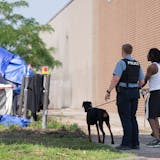Last week, in the course of his 53rd traffic stop in 14 years, Philando Castile was killed, for reasons that remain largely unexplained. Gov. Mark Dayton said the following day that if Castile had been white, he likely would still be alive. Instead, his death has occasioned another outpouring of pain over racial injustice.
The events of this summer echo back to 1967, when 75 American cities experienced major racial disturbances — often triggered by police brutality. A presidential commission created to study the crisis laid the blame squarely on a system of racial apartheid designed to separate black families from white society. In its words:
"Our nation is moving toward two societies, one black, and one white — separate and unequal. Segregation and poverty have created in the racial ghetto a destructive environment totally unknown to most white Americans. What white Americans have never fully understood … is that white society is deeply implicated in the ghetto. White institutions created it, white institutions maintain it and white society condones it."
The commission understood that the suffering of black Americans was intrinsically bound up in segregation. And it understood that segregation was not merely a system of separation, but a system of dominance, through which black Americans were held at a remove by powerful economic, social and political forces, including law enforcement.
The commission urged the country to reverse course. At first, Minnesota was at the forefront of this work. Between 1968 and 1985, the Twin Cities adopted proactive school and neighborhood integration policies that reduced segregation and closed racial disparities, building the groundwork for prosperity, stability and equal treatment for all.
But as the sense of crisis diminished, integration efforts slowed. Plans to maintain diverse schools and to ensure that housing was mixed by income were eliminated. A seductive myth took hold: the idea that, like distant colonies, segregated neighborhoods could be lifted out of poverty and despair by a concentrated program of uplift, without troubling the region's white enclaves, which were already well-fortified against poor or nonwhite intrusion.
Segregated neighborhoods once described as racial ghettos, deliberately invoking Europe's bitter history of confining unwanted social groups, were euphemistically retermed "RCAPs" — racially concentrated areas of poverty. The existence of such places is now often taken as inevitable.
Sociologist Kenneth Clark once described inner-city neighborhoods as "colonies of white society" where "social agencies are financially precarious and dependent upon sources of support outside the community." The Twin Cities area often has seemed determined to prove him right.



